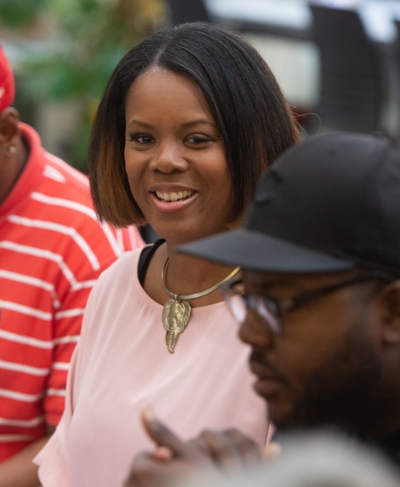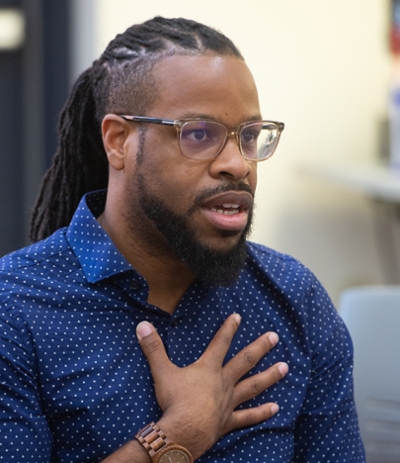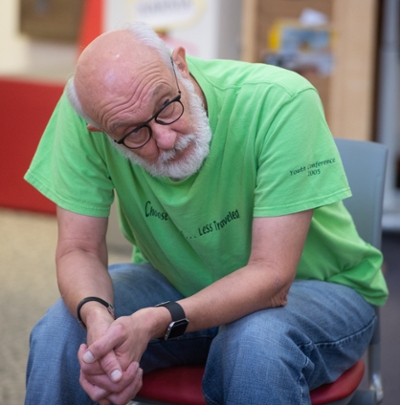 Within the circle, feelings of hurt, anger and reflection were shared with open honesty, and were met with understanding and support. The Southern Illinois University Edwardsville East St. Louis Charter High School (CHS) hosted “Coffee, Conversation and Dessert” on Friday, Aug. 9. The event dealt with the Netflix miniseries, “When They See Us,” created, co-written and directed by Ava DuVernay, and was coordinated and hosted by CHS Director Gina Jeffries, EdD.
Within the circle, feelings of hurt, anger and reflection were shared with open honesty, and were met with understanding and support. The Southern Illinois University Edwardsville East St. Louis Charter High School (CHS) hosted “Coffee, Conversation and Dessert” on Friday, Aug. 9. The event dealt with the Netflix miniseries, “When They See Us,” created, co-written and directed by Ava DuVernay, and was coordinated and hosted by CHS Director Gina Jeffries, EdD.
“When They See Us” was premiered as a four-part series beginning on May 31 and was based on the events of the 1989 Central Park, New York jogger criminal case, where a white woman was assaulted and raped. She was one of nine victims attacked. A total of 10 suspects were arrested for the crimes. Of those, five teenagers were wrongfully convicted of raping a woman. A serial rapist confessed to the crime after the teens had spent from six-13 years in prison.
 “I cried the whole four hours of the series. It was so emotionally charged for me,” said Pamela Saffore, CHS counselor. “It was something I felt could happen to any of the young boys I’ve encountered.”
“I cried the whole four hours of the series. It was so emotionally charged for me,” said Pamela Saffore, CHS counselor. “It was something I felt could happen to any of the young boys I’ve encountered.”
“I haven’t watched it yet,” said Johnathan Tate, CHS Science, Technology, Engineering and Mathematics (STEM) instructor. “I understood that I would have to be emotionally prepared to take in the series, and I just knew I wasn’t ready.”
Eighty-three-year-old Reginald Petty, civil rights leader, activist, educator, author, historian and former Peace Corp director, reminisced and voiced alarm at today’s current events. “We fought for civil rights in my time,” said Petty. “Back then, injustice was not a surprise. My concern is that we thought that by this time, things like this would not be happening.”
“How did this false perception of black men illustrated in the movie change the overall perception of black males from your perspective?” Jeffries asked the group.
 “It didn’t,” said Jeremy Snipes, PhD, assistant professor in the Department of Educational Leadership. “When you trace the history of black youth and criminality, you will find that the two have been wrongly linked together. I was a young child when this case happened, but to see the actors being dragged through the police station and assaulted weighed heavy on me, because it is not new. That is the sad thing.”
“It didn’t,” said Jeremy Snipes, PhD, assistant professor in the Department of Educational Leadership. “When you trace the history of black youth and criminality, you will find that the two have been wrongly linked together. I was a young child when this case happened, but to see the actors being dragged through the police station and assaulted weighed heavy on me, because it is not new. That is the sad thing.”
“As it relates to perception, I thought about how I was raised,” said Carolyn Kribs, CHS social studies instructor. “I was raised to believe that if you don’t do anything wrong, then you don’t have anything to worry about. That fact is not reality for everyone.”
“There is a much larger problem with people, and I don’t know if it’s fixable,” said Colin Neumeyer, CHS English and Spanish instructor. “I have a stake in this, because I work here. But where I live, the fluidness and ease of racism is something to take note of. I feel it all the time, and it’s ugly.”
Shawn Roundtree, CHS social worker, confessed his fears for his African American sons. “You have to tell your black children what to do and how to act if they are pulled over by the police,” Roundtree interjected. “They are nice kids, but I don’t want them taken advantage of or accused of something they didn’t do. Worse, I don’t want them to get arrested or harmed. It’s unnerving that they have to live like that.”
In another line of questioning, Jeffries asked the group about black males and education. “When we look at boys of color how do perceptions hinder them in the educational system? How is that related to the school to prison pipeline?”
“It bothers me that black boys can be seen and treated as if they are not boys,” said Bridget Nelson, English instructor. “When you don’t see them as children, it’s very problematic.”
“I work with our boys to let them know that first impressions are important,” said Roundtree. “I also let them know that some people have bad perceptions of black males, and they need to work to counteract that.”
“There is a societal logic that makes the argument easy to accept that black boys get what is coming to them,” added Snipes. “The logic is so deeply engrained that even when confronted with the truth, some people’s perceptions remain unchanged. Our children are equally deserving of praise and love.”
“We don’t have a collective imagination of black brilliance,” Snipes continued. “I challenge everyone to see value, brilliance and wisdom in our black youth.”
Part two of the “When They See Us” discussion will occur with student participation during Diversity Day on Tuesday, Oct. 15.
The SIUE Charter High School is a school-of-choice for families in the East St. Louis School District 189. The mission of the Southern Illinois University Edwardsville East St. Louis Charter High School is to prepare students who are career- and college-ready upon graduation. To achieve this mission, the school and its staff will positively impact the educational and economic lives of East St. Louis, Illinois youth through individualized instruction in core academic subjects, exploration of career interests and aptitudes, assistance in realizing students’ talents, high academic goals, and expectations that graduates will become competitive employees for the 21st century.
Photos:
SIUE East St. Louis Charter High School Director Gina Jeffries, EdD, was the moderator and coordinator of the “Coffee, Conversation and Dessert” event. In the foreground is Johnathan Tate, CHS Science, Technology, Engineering and Mathematics (STEM) instructor.
Participating in the conversation is Jeremy Snipes, PhD, assistant professor in the Department of Educational Leadership.
CHS math instructor Basil Yurcision listens to the discussion.